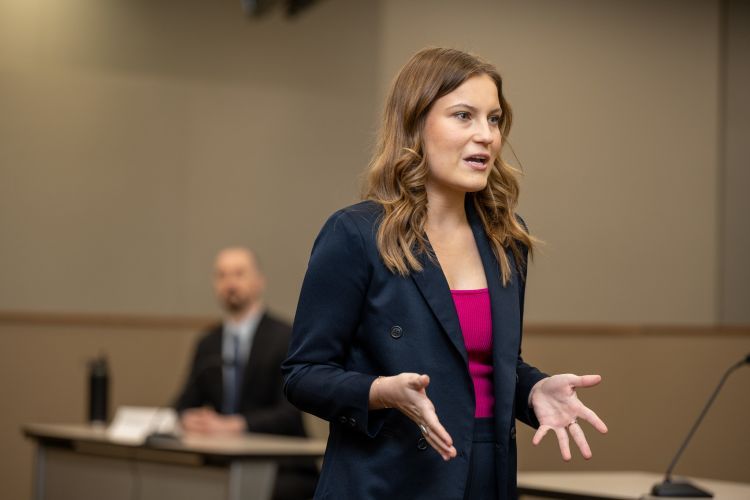Navigating the Intricacies of Trial Presentations: Tips for Seamless Distribution and Compelling Arguments
In the realm of lawful proceedings, the art of test discussion stands as a crucial component of success. The intricacies fundamental in trial presentations need a fragile equilibrium of skill, finesse, and technique.

Understanding Trial Purposes
To efficiently browse a test, it is crucial to have a clear understanding of the goals that require to be attained. Prior to entering the court, lawful groups have to define their goals and desired results. These goals offer as leading principles throughout the trial, shaping techniques and influencing decision-making procedures.
Comprehending test purposes entails a comprehensive analysis of the case, legal precedents, and the client's best interests. Trial Presentations. It requires a precise evaluation of the truths, determining essential concerns, and preparing for possible obstacles. By setting measurable and specific objectives, lawyers can tailor their disagreements and presentations to straighten with the wanted outcomes
Additionally, a clear understanding of trial objectives enables lawful groups to prioritize evidence, witnesses, and lawful debates successfully. It enables for the development of a coherent story that reverberates with the discretionary, reinforcing the general case discussion.

Organizing Proof Properly
Having a clear understanding of test purposes lays the structure for organizing evidence properly in lawful procedures - Trial Presentations. By lining up the presentation of proof with the wanted results of the trial, lawful groups can enhance their arguments and boost their persuasiveness. One critical facet of organizing evidence is classification. Grouping evidence based upon styles or relevance to details lawful elements can aid simplify the presentation and make complex details much more digestible for the court or jury.
An additional key component in organizing proof efficiently is developing a logical circulation. Presenting proof in a sequential and systematic manner can aid build an engaging story that supports the lawful arguments being made. Furthermore, using visual help such as timelines, charts, or charts can further improve the organization of proof and aid in clarifying complicated partnerships or sequences of occasions.
In addition, guaranteeing that all proof offered is admissible and appropriate to the situation is important. Unnecessary or inadmissible evidence can take away from the toughness of the argument and potentially hurt the reputation of the presenting celebration. A careful check my reference testimonial and option procedure need to be taken on to consist of just the most legitimately audio and impactful proof in the test discussion.
Crafting Convincing Stories
Crafting engaging narratives plays a crucial function in presenting convincing arguments throughout legal process. When building a story for a trial presentation, it is necessary to establish a clear story that highlights essential factors and links them in a systematic way. By weaving with each other evidence, testimony, and legal arguments into a influential and cohesive story, legal experts can effectively promote for their clients and boost the likelihood of a positive outcome in the court.
Understanding Visual Help
Reliable use aesthetic help is essential to improving the influence and clarity of test discussions. Visual aids, i was reading this when used purposefully, have the power to simplify complicated details, reinforce essential factors, and leave a lasting impression on the discretionary. To understand visual aids in trial discussions, it is critical to guarantee that they are clear, concise, and pertinent to the debates being made.
When incorporating visual aids, such as charts, charts, timelines, or pictures, right into a test discussion, it is vital to keep them visually appealing yet professional. The visuals ought to match the verbal disagreements, supplying a graph of the info being gone over without frustrating the target market with unneeded information.
Additionally, exercising with the visual aids in advance is necessary to make certain a smooth delivery throughout the trial. Familiarizing oneself with the content, transitions, and timings of each aesthetic help can assist preserve the flow of the presentation and stop technical problems that may arise.
Delivering Impactful Closing Arguments
A compelling closing disagreement serves as the end result of a test presentation, encapsulating the core story and convincing the judge and court in the direction of a positive choice. Begin by outlining the main arguments that sustain your customer's placement, stressing why the proof presented throughout the trial supports your story.
In addition, incorporating emotional charm can further enhance your closing debate. Ultimately, a well-crafted closing debate must leave an enduring impression, compelling the judge and court to rule in your client's favor.
Final Thought
Finally, grasping test presentations entails comprehending purposes, organizing proof, crafting stories, utilizing aesthetic aids, and providing impactful closing debates. By executing these techniques effectively, attorneys can offer their situation seamlessly and make click compelling disagreements in the court. It is important to browse the complexities of trial discussions with accuracy and skill to accomplish success in lawful proceedings.
By lining up the presentation of evidence with the wanted results of the test, legal teams can strengthen their debates and enhance their persuasiveness (Trial Presentations). To master aesthetic aids in test presentations, it is essential to ensure that they are clear, concise, and relevant to the arguments being made
A compelling closing argument offers as the conclusion of a trial discussion, enveloping the core narrative and persuading the judge and jury towards a beneficial choice. Begin by detailing the major debates that sustain your customer's placement, stressing why the evidence offered throughout the test supports your narrative.In final thought, mastering test presentations entails comprehending objectives, arranging evidence, crafting stories, using visual help, and delivering impactful closing disagreements.